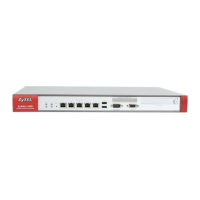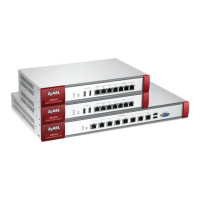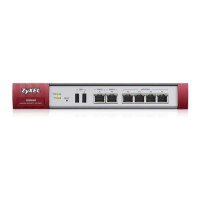Chapter 29 IPSec VPN
ZyWALL/USG Series User’s Guide
563
In main mode, the ZyWALL/USG and remote IPSec router authenticate each other in steps 5 and 6,
as illustrated below. The identities are also encrypted using the encryption algorithm and
encryption key the ZyWALL/USG and remote IPSec router selected in previous steps.
Figure 386 IKE SA: Main Negotiation Mode, Steps 5 - 6: Authentication (continued)
You have to create (and distribute) a pre-shared key. The ZyWALL/USG and remote IPSec router
use it in the authentication process, though it is not actually transmitted or exchanged.
Note: The ZyWALL/USG and the remote IPSec router must use the same pre-shared key.
Router identity consists of ID type and content. The ID type can be domain name, IP address, or e-
mail address, and the content is a (properly-formatted) domain name, IP address, or e-mail
address. The content is only used for identification. Any domain name or e-mail address that you
enter does not have to actually exist. Similarly, any domain name or IP address that you enter does
not have to correspond to the ZyWALL/USG’s or remote IPSec router’s properties.
The ZyWALL/USG and the remote IPSec router have their own identities, so both of them must
store two sets of information, one for themselves and one for the other router. Local ID type and
content refers to the ID type and content that applies to the router itself, and peer ID type and
content refers to the ID type and content that applies to the other router.
Note: The ZyWALL/USG’s local and peer ID type and content must match the remote
IPSec router’s peer and local ID type and content, respectively.
For example, in Table 215 on page 563, the ZyWALL/USG and the remote IPSec router authenticate
each other successfully. In contrast, in Table 216 on page 564, the ZyWALL/USG and the remote
IPSec router cannot authenticate each other and, therefore, cannot establish an IKE SA.
Step 5:
pre-shared key
ZyWALL/USG identity, consisting of
- ID type
- content
Step 6:
pre-shared key
Remote IPSec router identity, consisting of
- ID type
- content
Table 215 VPN Example: Matching ID Type and Content
ZYWALL/USG REMOTE IPSEC ROUTER
Local ID type: E-mail Local ID type: IP
Local ID content: tom@yourcompany.com Local ID content: 1.1.1.2
Peer ID type: IP Peer ID type: E-mail
Peer ID content: 1.1.1.2 Peer ID content: tom@yourcompany.com

